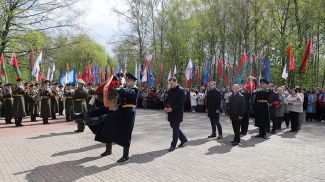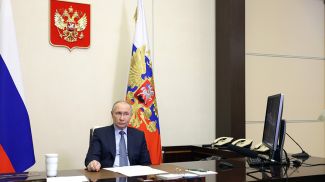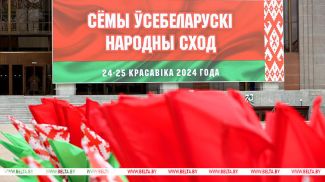MINSK, 2 June (BelTA) – The Prosecutor General's Office has contacted the relevant Lithuanian authorities with a request to provide legal aid in investigating a criminal case into the genocide of the Belarusian population. The request was made in accordance with the Belarusian-Lithuanian agreement on legal aid and legal relations in civil cases, family cases, and criminal cases, BelTA learned from the Prosecutor General's Office press service.
The Prosecutor General's Office continues investigating a criminal case, which was opened in accordance with Article 127 (genocide) of the Criminal Code. The investigation team is looking into what the Nazi, their accomplices, and armed gangs did during the Great Patriotic War of 1941-1945 in the course of systematic elimination of Soviet citizens, including Belarusians and representatives of other nationalities, by means of mass murders and the deliberate creation of conditions conducive to their elimination.
The investigation team is busy looking into information about punitive operations, the elimination of populated localities together with their residents, the creation of ghettos, concentration camps, and death camps such as Trostenets and Ozarichi, the forced movement of civilians to Germany for forced labor. Over 2 million people died in Belarus as a result of the genocide.
According to the Prosecutor General's Office, volunteers of Lithuanian collaborationist units led by agencies of the German Reich took part in the systematic elimination of the Belarusian population in 1941-1944. Members of these organizations swore an oath of allegiance to the Nazi Germany and its leaders. According to materials of the criminal case, the 2nd Lithuanian battalion (identified as the 12th battalion later on), the 3rd Lithuanian battalion, and the 15th Lithuanian battalion were directly involved in the “pacification” and “special treatment” of the Belarusian population. Those are the terms used by official documents of the German occupation authorities to describe the genocide of the Belarusian people.
In particular, during the punitive operation Swamp Fever the 3rd and 15th battalions shot at least 200 refugees as well as residents of the populated localities of Starobin, Andrashovshchizna, Tsekovka, and Zharkov.
During Operation Hamburg the 15th Lithuanian battalion shot 20 residents of Derechina and carried out mass murders in the area of Nesvizh, Kopyl, and Stolbtsy. Violence was used to move at least 200 residents of Lida District to Germany for forced labor.
The 2nd (12th) Lithuanian battalion led by Antanas Liudviko Impulevicius-Impulenas (aka the Minsk Butcher) consisted of volunteers, who lived in the territory of modern Lithuania and carried out punitive operations in Minsk, Minsk Oblast, and Brest Oblast. The battalion murdered dozens of thousands of innocent people.
On 27 and 28 October 1941 upon personal instructions of the Minsk Butcher (Impulevicius) the battalion eliminated at least 5,000 prisoners in the Slutsk ghetto. During this operation people were forcefully led out of residential premises, violently beaten with sticks, rubber hoses, and weapon butts. At the site of their execution in the village of Gorevakha they were forced to take off all their clothes, lie face down in the pit in groups of 25 people on top of the people, who had already been shot, and then they were shot. Pits with people, who still demonstrated vital signs, were covered with soil. Lithuanian volunteers demonstrated special ruthlessness and used methods, which inflicted lasting pain and torment and caused special physical and psychical suffering, to kill about 1,750 Jews in Berezino District and 4,166 prisoners of the Minsk ghetto in 1941 alone. Troops of the 2nd (12th) Lithuanian battalion killed at least 7,000 civilians in Minsk Oblast in October 1941 alone.
Later on this battalion together with other collaborationist units took part in a number of other punitive operations, including Operation Winter Magic (Winterzauber) in February-March 1943. The operation was designed to employ scorched earth tactics to rule out the presence of residents in a strip 30-40km wide along the Latvian border.
The operation resulted in the destruction of 387 populated localities, deaths of over 13,000 civilians, and the forceful extraction of over 7,000 people for forced labor. The genocide reduced the population of Osveya District, Vitebsk Oblast by more than 60% and the population of Drissa District by 52%.
The investigation team is looking into other multiple facts of atrocities committed by nationalistic punitive units. According to the Prosecutor General's Office, many murders were barbaric and entailed lengthy and painful deaths. In the village of Belyany troops of the punitive expedition used a knife to carve five-pointed stars on the chest and the back of an eight-year-old boy, who was then thrown into a fire. The head of a child, who was 1.5 years old, was smashed and the fingers were torn out before the body was thrown into a fire. A seven-year-old girl was murdered with a knife. The mother was cut up and burned. In the village of Borisovo wounds were inflicted upon hands and necks of all members of one family – adults and kids –before the people were drowned in the Svolna River. In the village of Volodarka as many as 146 women and children were tied together, gasoline was poured over them, and then they were burned.
As the Red Army was approaching Lithuanian borders, the Minsk Butcher (Impulevicius) and other troops of the 2nd (12th) Lithuanian battalion took part in actions of other armed collaborationist units: the Lithuanian Territorial Defense Force (Lietuvos vietine rinktine) and the Fatherland Defense Force (Tevynes apsaugos rinktine) were subordinated to and supplied by the Nazi Germany. The investigation team is trying to verify information that Voldemaras Hubertas Laimutis Adamkavicius volunteered to join the staff of the so-called Fatherland Defense Force as a personal liaison officer of the Minsk Butcher (Impulevicius).
After Belarusian and Lithuanian lands were liberated from the German invaders, some of the troops of the Lithuanian volunteer units, including the Minsk Butcher (Impulevicius) and Adamkavicius, went into hiding in the territory of Germany, which was in the responsibility area of the USA and the UK. In 1949 they moved to the USA to avoid responsibility for their crimes.
Later on the Minsk Butcher (Impulevicius) was found guilty of mass murders (classified as genocide at present) and sentenced to death in absentia by the Supreme Court of the Lithuanian Soviet Socialist Republic. However, the USA refused to extradite him. Voldemaras Hubertas Laimutis Adamkavicius changed his name to Valdas Adamkus, returned to Lithuania, and became a president of the Republic of Lithuania in the 1990s.
The investigation team has a list of names of members of the 2nd (12th) Lithuanian battalion and photos of some of the troops. The ongoing investigation will have to clarify the role of every identified member of the battalion and the role of Valdas Adamkus in the genocide of civilians. It will be necessary to find out whether they have been punished for their crimes.
“The Prosecutor General's Office of Belarus believes that Lithuanian colleagues have enough commitment and common sense to properly honor their international obligations,” the press service concluded.











